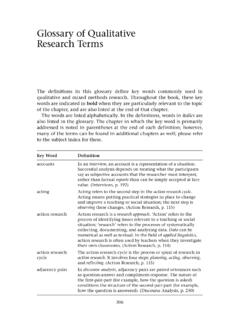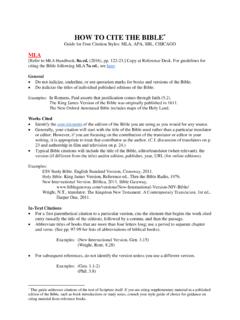Transcription of Theoretical Neuroscience
1 Theoretical NeuroscienceComputational NeuroscienceTerrence J. Sejnowski and Tomaso Poggio, editorsNeural Nets in Electric Fish,Walter Heiligenberg, Computational Brain,Patricia S. Churchland and Terrence J. Sejnowski,1992 Dynamic Biological Networks: The Stomatogastric Nervous System,edited byRonald M. Harris-Warrick, Eve Marder, Allen I. Selverston,andMaurice Moulins, 1992 The Neurobiology of Neural Networks,edited by Daniel Gardner, 1993 Large-Scale Neuronal Theories of the Brain,edited by Christof Koch and JoelL. Davis, 1994 The Theoretical Foundations of Dendritic Function: Selected Papers of WilfridRall with Commentaries,edited by Idan Segev, John Rinzel, and GordonM. Shepherd, 1995 Models of Information Processing in the Basal Ganglia,edited by James , Joel L.
2 Davis, and David G. Beiser, 1995 Spikes: Exploring the Neural Code,Fred Rieke, David Warland, Rob deRuyter van Steveninck, and William Bialek, 1997 Neurons, Networks, and Motor Behavior,edited by Paul Stein, StenGrillner, Allen I. Selverston, and Douglas G. Stuart, 1997 Methods in Neuronal Modeling: From Ions to Networks,second edition,edited by Christof Koch and Idan Segev, 1998 Fundamentals of Neural Network Modeling: Neuropsychologyand CognitiveNeuroscience,edited by Randolph W. Parks, Daniel S. Levine, and DebraL. Long, 1998 Neural Codes and Distributed Representations: Foundations of NeuralComputation,edited by Laurence Abbott and Terrence J. Sejnowski, 1998 Unsupervised Learning: Foundations of Neural Computation,edited byGeoffrey Hinton and Terrence J.
3 Sejnowski, 1998 Fast Oscillations in Cortical Circuits,Roger D. Traub, John Jeffreys,and Miles A. Whittington, 1999 Computational Vision: Information Processing in Perception and VisualBehavior,Hanspeter A. Mallot, 2000 Theoretical Neuroscience : Computational and Mathematical Modeling of NeuralSystems,Peter Dayan and Abbott, 2001 Theoretical NeuroscienceComputational and Mathematical Modeling ofNeural SystemsPeter Dayan and AbbottThe MIT PressCambridge, MassachusettsLondon, EnglandFirst MIT Press paperback edition, 2005c 2001 Massachusetts Institute of TechnologyAll rights reserved. No part of this book may be reproduced inany form by anyelectronic or mechanical means (including photocopying, recording, or informa-tion storage and retrieval) without permission in writing from the Press books may be purchased at special quantity discounts for business orsales promotional use.
4 For information, please write to Special Sales Department, The MIT Press, 55 Hayward Street, Cam-bridge, MA in Palatino by the authors using LATEX 2 .Printed and bound in the United States of of Congress Cataloging-in-Publication DataDayan, Neuroscience : computational and mathematical modeling of neuralsystems / Peter Dayan and cm. (Computational Neuroscience )Includes bibliographical 0-262-04199-5 (hc. : alk. paper) 0-262-54185-8 (pb.)1. Neural networks (Neurobiology) Computer simulation. 2. Humaninformation processing Computer simulation. 3. Computational Abbott, II. Title. III..D39 01 13- -dc21200104400510 9 8 7 6 5 4To our familiesContentsPrefacexiiiI Neural Encoding and Decoding11 Neural Encoding I: Firing Rates and Spike Trains and Firing Makes a Neuron Fire?
5 Neural Bibliography432 Neural Encoding II: Reverse Correlation and Visual Firing to the Early Visual Methods: Simple Nonlinearities: Complex Fields in the Retina and V1 Receptive annotated Bibliography843 Neural and Bibliography1224 Information and Mutual and Entropy and Information for Spike Bibliography150II Neurons and Neural Circuits1515 Model Neurons I: Properties of Hodgkin-Huxley on Integrate-and-Fire Chapter annotated Bibliography1936 Model Neurons II: Conductances and of Neuron Cable Bibliography2287 Network Bibliography277 III Adaptation and Learning2798 Plasticity and Plasticity Bibliography3289 Classical Conditioning and Reinforcement Action Action Bibliography35710 Representational Density Causal Models for Density Chapter annotated Bibliography396 Mathematical Linear Finding Extrema and Lagrange Differential Electrical Probability annotated Bibliography418 References419 Index439 ForewordComputational Neuroscience is an approach to understanding the infor-mation content of neural signals by modeling the nervous system at manydifferent structural scales, including the biophysical, the circuit.
6 And thesystems levels. Computer simulations of neurons and neuralnetworks arecomplementary to traditional techniques in book serieswelcomes contributions that link Theoretical studies withexperimental ap-proaches to understanding information processing in the nervous and topics of particular interest include biophysical mechanisms forcomputation in neurons, computer simulations of neural circuits, modelsof learning, representation of sensory information in neural networks, sys-tems models of sensory-motor integration, and computational analysis ofproblems in biological sensing, motor control, and J. SejnowskiTomaso PoggioPrefaceTheoretical analysis and computational modeling are important tools forcharacterizing what nervous systems do, determining how they function,and understanding why they operate in particular ways.
7 Neuroscienceencompasses approaches ranging from molecular and cellular studies tohuman psychophysics and psychology. Theoretical Neuroscience encour-ages crosstalk among these subdisciplines by constructingcompact repre-sentations of what has been learned, building bridges between differentlevels of description, and identifying unifying concepts and principles. Inthis book, we present the basic methods used for these purposes and dis-cuss examples in which Theoretical approaches have yieldedinsight intonervous system questions what, how, and why are addressed by descriptive, mecha-nistic, and interpretive models, each of which we discuss inthe followingchapters. Descriptive models summarize large amounts of experimentaldescriptive modelsdata compactly yet accurately, thereby characterizing what neurons andneural circuits do.
8 These models may be based loosely on biophysical,anatomical, and physiological findings, but their primary purpose is todescribe phenomena, not to explain them. Mechanistic models, on themechanistic modelsother hand, address the question of how nervous systems operate on thebasis of known anatomy, physiology, and circuitry. Such models oftenform a bridge between descriptive models couched at different levels. In-terpretive models use computational and information-theoretic principlesinterpretive modelsto explore the behavioral and cognitive significance of various aspects ofnervous system function, addressing the question of why nervous systemsoperate as they is often difficult to identify the appropriate level of modeling for a partic-ular problem.
9 A frequent mistake is to assume that a more detailed modelis necessarily superior. Because models act as bridges between levels ofunderstanding, they must be detailed enough to make contactwith thelower level yet simple enough to provide clear results at thehigher and ApproachThis book is organized into three parts on the basis of general I, Neural Encoding and Decoding, (chapters 1 4) is devoted to thecoding of information by action potentials and the representation of in-xivPrefaceformation by populations of neurons with selective responses. Model-ing of neurons and neural circuits on the basis of cellular and synapticbiophysics is presented in part II, Neurons and Neural Circuits (chapters5 7). The role of plasticity in development and learning is discussed inpart III, Adaptation and Learning (chapters 8-10).
10 With theexception ofchapters 5 and 6, which jointly cover neuronal modeling, thechapters arelargely independent and can be selected and ordered in a variety of waysfor a one- or two-semester course at either the undergraduate or the grad-uate we provide some background material, readers without previ-ous exposure to Neuroscience should refer to a neurosciencetextbook suchbackgroundas Kandel, Schwartz, & Jessell (2000); Nicholls, Martin, & Wallace (1992);Bear, Connors, & Paradiso (1996); Shepherd (1997); Zigmondet al. (1998);or Purves et al. (2000). Theoretical Neuroscience is based on the belief that methods of mathemat-ics, physics, and computer science can provide important insights into ner-vous system function. Unfortunately, mathematics can sometimes seemmore of an obstacle than an aid to understanding.






